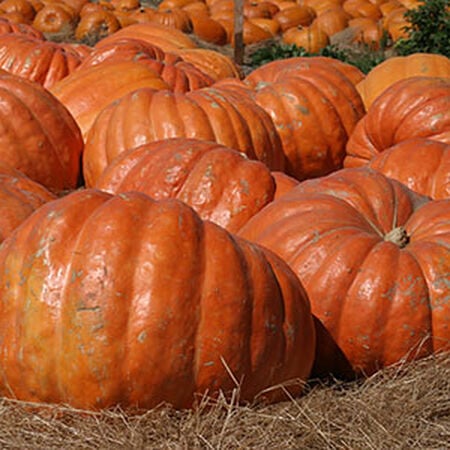Atlantic Giant, Pumpkin Seeds
Key Attributes
Atlantic Giant pumpkins are renowned for their impressive size and are considered one of the largest pumpkin varieties in the world. Developed specifically for growing colossal pumpkins, they can reach weights of over 1,000 pounds, with some exceptional specimens exceeding 2,000 pounds! Characterized by their thick, ribbed, orange skin, Atlantic Giants are not just visually striking but also have a relatively mild flavor, making them less ideal for cooking compared to smaller varieties.
Originating from a selective breeding program in the 1970s, Atlantic Giant pumpkins have gained popularity in pumpkin-growing competitions and festivals. The plants require ample space and nutrient-rich soil, thriving in warm climates with plenty of sunlight and consistent watering.
Harvesting typically occurs in late summer to early fall when the pumpkins have reached their desired size and the skin has hardened. Despite their massive size, they can be surprisingly delicate; care must be taken during handling to avoid bruising. Atlantic Giant pumpkins are not only a favorite for competitive growers but also serve as a fun and impressive display during autumn festivals, making them a staple of Halloween decor and seasonal celebrations.
Key Attributes
Product Details
Weight
0.018Depth
0.2Height
4.5Width
3.25Plant Height
12-24"Botanical Name
Cucurbita maximaSeed Type
SeedSeeds Per Gram
4Seeds Per Pound
1,660Row Spacing
8-12'Packet
10 SeedsSow Depth
1"Seeds Per Ounce
104Fruit Color
OrangeBreed
Open-pollinatedSun
Full SunTypes
GIANT PUMPKINSMaturity
Late SeasonFruit Weight
200-500Cubic Inches
2.925Life Cycle
AnnualSow Method
Direct SowPlant Spacing
24-36"Categories
PumpkinGermination
4,5,6,7,8,9Days To Maturity (# Days)
130Seeds Per Acre
9 lbsComponents
Growing Instructions
![]() Learning Download: How to Grow Pumpkins
Learning Download: How to Grow Pumpkins
Pumpkins can be grown for decorative and edible purposes, with different varieties grown to make pumpkin pie, carving for Halloween, to be used in canning and more. Pumpkins range in sizes from small, gourd-like varieties to large options and differ in color and outside texture as well.
Before Planting: Pumpkins like fertile, well-drained soil with a pH of 6-6.5. Row covers can protect seedlings for several weeks. Row covers should be removed when plants begin to flower. Time plantings so that varieties will mature for the fall market. Planting too early can lead to dead foliage and over exposure to sun.
Planting: Direct seeding is the easiest and most successful method of planting. Sow in late spring when soil is at least 70°F and danger of frost has passed. Sow 2 seeds at the appropriate spacing interval for the variety’s vine length, 1″ deep. Thin to 1 plant per spacing interval after seedlings are established. For transplanting, sow 2-3 seeds per 2″ container or plug flat about 3 weeks prior to transplanting. Transplant should be no older than 3 weeks as stunting and damage can happen. Thin to 1 plant/container or cell with scissors. Harden plants 4–7 days prior to transplanting. After danger of frost has passed, transplant out according to the spacing recommendations for each variety. Handle seedlings carefully; minimal root disturbance is best. Bush to short-vine habits generally require 6′ between-row spacing, while long-vine habits generally require 10-12′ between-row spacing. In-row spacing varies depending on fruit size and is generally: small, 18-24″; medium, 24-36″ and large to extra-large, 36-72″. Spacing requirements may vary, so check under characteristics for each variety.
Watering: Water the pumpkins 1 inch per week, but don’t let water get on the leaves or the fruit.
Fertilizer: Pumpkins are heavy feeders with a long growing season. Prior to planting in the garden, add compost and aged manure to the soil. Add 1 cup of complete organic fertilizer below each plant prior to sowing and mix the fertilizer into the soil. Regularly treat pumpkins with compost and manure mixed with water or feed weekly with a fish or kelp-based fertilizer. Another option for fertilizing is to use a high-nitrogen fertilizer when plants are 1 foot tall and a high-phosphorous fertilizer before the blooming period starts.
Days to Maturity: Pumpkins are ready to harvest when the color they are supposed to become is deep and rich. (See each variety for days to maturity)
Harvesting: When fruit color is fully developed, clip handles close to the vine. Avoid picking up fruits by handles and take care not to damage the skin/rind. Sun cure in the field for 5-7 days. If possible store at 50-60°F with 50-70% humidity and good ventilation.
Tips: Common cucurbit diseases include powdery mildew, downy mildew, bacterial wilt, and phytophthora. Avoid problems with adequate soil drainage, good air flow, insect pest control, and crop rotation.
AVG. Seed Rate: 250 seeds/125′, 500 seeds/250′, 1,000 seeds/500′, 15M/acre @ 2 seeds/ft rows 6′ apart.
Shipping Schedule
Our Seed Promise
 "Agriculture and seeds" provide the basis upon which our lives depend. We must protect this foundation as a safe and genetically stable source for future generations. For the benefit of all farmers, gardeners and consumers who want an alternative, we pledge that we do not knowingly buy or sell genetically engineered seeds or plants.
"Agriculture and seeds" provide the basis upon which our lives depend. We must protect this foundation as a safe and genetically stable source for future generations. For the benefit of all farmers, gardeners and consumers who want an alternative, we pledge that we do not knowingly buy or sell genetically engineered seeds or plants.
The mechanical transfer of genetic material outside of natural reproductive methods and between genera, families or kingdoms, poses great biological risks as well as economic, political, and cultural threats. We feel that genetically engineered varieties have been insufficiently tested prior to public release. More research and testing is necessary to further assess the potential risks of genetically engineered seeds. Further, we wish to support agricultural progress that leads to healthier soils, to genetically diverse agricultural ecosystems, and ultimately to healthy people and communities.
To learn more about the "Safe Seed Pledge" please visit www.councilforresponsiblegenetics.org.

